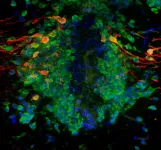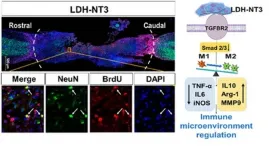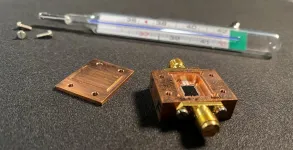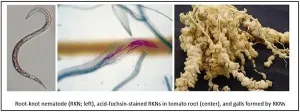Algorithms inspired by social networks reveal lifecycle of substorms, a key element of space weather
Evolution of auroral substorms revealed by physicists at University of Warwick using the same methods that link people through social media
2021-03-23
(Press-News.org) Evolution of auroral substorms revealed by physicists at University of Warwick using the same methods that link people through social media
'If you like this magnetometer, you might like this one too:' historical data from magnetometers used to match them with 'like-minded friends' during 41 substorms
Shows that a single coherent electrical current, that accompanies the Northern Lights during substorms, covers most of the Earth's night-side at high latitudes
Will help to validate models used to predict auroral substorms, which can disrupt electronics and power distribution systems
Space weather often manifests as substorms, where a beautiful auroral display such as the Northern Lights is accompanied by an electrical current in space which has effects at earth that can interfere with and damage power distribution and electrical systems. Now, the lifecycle of these auroral substorms has been revealed using social media-inspired mathematical tools to analyse space weather observations across the Earth's surface.
Analysis by researchers led by the University of Warwick has revealed that these substorms manifest as global-scale electrical current systems associated with the spectacular aurora, reaching across over a third of the globe at high latitudes.
New research which involves the University of Warwick, John Hopkins University - Applied Physics Laboratory, University of Bergen and Cranfield University, and published today (23 March) in the journal Nature Communications processes data on disturbances in the Earth's magnetic field from over a hundred magnetometers in the Northern hemisphere using a new technique that enables them to find 'like-minded friends'.
Magnetometers register changes in the Earth's magnetic field. When charged particles from our Sun bombard the Earth's magnetic field, it stores up energy like a battery. Eventually, this energy is released leading to large-scale electrical currents in the ionosphere which generate disturbances of magnetic fields on the ground. At extremes, this can disrupt power lines, electronic and communications systems and technologies such as GPS.
Using historical data from the SuperMAG collaboration of magnetometers, the researchers applied algorithms from network science to find correlations between magnetometer signals during 41 known substorms that occurred between 1997-2001. These use the same principles that allow a social networking site to recommend new friends, or to push relevant advertisements to you as you browse the internet.
Magnetometers detecting coherent signals were linked into communities, regardless of where they were located on the globe. As time progressed, they saw each substorm develop from many smaller communities into a single large correlated system or community at its peak. This led the authors to conclude that substorms are one coherent current system which extends over most of the nightside high latitude globe, rather than a number of individual small and disjointed current systems.
Dr Lauren Orr, who led the research as part of her PhD at the University of Warwick Department of Physics and is now based at Lancaster University, said: "We used a well-established method within network science called community detection and applied it to a space weather problem. The idea is that if you have lots of little subgroups within a big group, it can pick out the subgroups.
"We applied this to space weather to pick out groups within magnetometer stations on the Earth. From that, we were trying to find out whether there was one large current system or lots of separate individual current systems.
"This is a good way of letting the data tell us what's going on, instead of trying to fit observations to what we think is occurring."
Some recent work has suggested that auroral substorms are composed of a number of smaller electrical current systems and remain so throughout their lifecycle. This new research demonstrates that while the substorm begins as lots of smaller disturbances, it quite rapidly becomes a large system over the course of around ten minutes. The lack of correlation in its early stages may also suggest that there is no single mechanism at play in how these substorms evolve.
The results have implications for models designed to predict space weather. Space weather was included in the UK National Risk Register in 2012 and updated in 2017 with a recommendation for more investment in forecasting.
Co-author Professor Sandra Chapman adds: "Our research introduces a whole new methodology for looking at this data. We've gone from a data poor to a data rich era in space plasma physics and space weather, so we need new tools. It's a first to show that you can take one of these tools to our field and get a really important result out of it. We've had to learn a lot to be able to do that, but in doing so it opens up a new window into the data."
INFORMATION:
* 'Network Community Structure of Substorms using SuperMAG Magnetometers' will be published in Nature Communications, DOI: 10.1038/s41467-021-22112-4
Link: https://doi.org/10.1038/s41467-021-22112-4
(to go live after embargo lifts)
For interviews or a copy of the paper contact:
Peter Thorley
Media Relations Manager
(Warwick Medical School and Department of Physics) | Press & Media Relations | University of Warwick
Email: peter.thorley@warwick.ac.uk
Mob: +44 (0) 7824 540863
[Attachments] See images for this press release:
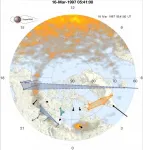
ELSE PRESS RELEASES FROM THIS DATE:
2021-03-23
A pioneering study, published in Scientific Reports, found that the Parkinon's gene PINK1 is important for the generation of dopamine-producing neurons throughout life, and is not just responsible for the premature death of these neurons
The international research, led by University of Sheffield's Neuroscience Institute, used two model systems to examine how neurons are produced throughout our lifetime
Parkinson's disease is a relentlessly progressive neurodegenerative disorder that affects around 145,000 people in the UK
A gene defect linked to Parkinson's disease may not only cause the early death of neurons, ...
2021-03-23
Hennigsdorf/Berlin, Germany, March 23, 2021 - Diagnostics company SphingoTec GmbH ("SphingoTec") announced today the first published data (1) on the biomarker DPP3 that can predict the evolution of organ function and survival in septic patients. Measured on top of routinely used standard parameters, such as Lactate and Procalcitonin, DPP3 is an early indicator of short-term outcomes and patient severity. Sepsis is a medical emergency caused by a dysregulated host response to an infection, with mortality rates increasing rapidly for each hour that appropriate treatment is delayed (2). The rapid evolution of sepsis into its severe form, septic shock, raises the need for more precise and faster testing to support better clinical decision-making.
DPP3 is an ...
2021-03-23
Researchers from the Department of Orthopedics of Tongji Hospital at Tongji University in Shanghai have successfully used a nanobiomaterial called layered double hydroxide (LDH) to inhibit the inflammatory environment surrounding spinal cord injuries in mice, accelerating regeneration of neurons and reconstruction of the neural circuit in the spine. The researchers were also able to identify the underlying genetic mechanism by which LDH works. This understanding should allow further modification of the therapy which, in combination with other elements, could finally produce a comprehensive, clinically applicable system for spinal cord injury relief in humans.
The ...
2021-03-23
Researchers at the University of Toronto have found that food industry interactions with government heavily outnumbered non-industry interactions on Bill S-228, also known as the Child Health Protection Act, which died in the Senate of Canada in 2019.
The researchers looked at more than 3,800 interactions, which included meetings, correspondence and lobbying, in the three years before the bill failed. They found that over 80 per cent were by industry, compared to public health or not-for-profit organizations.
They also found that industry accounted for over 80 per cent of interactions with the highest-ranking government offices, including elected parliamentarians and their staff and unelected ...
2021-03-23
BINGHAMTON, NY -- When it comes to local government, does the gender of a mayor or county executive matter in sustainability policymaking? Yes, but only in certain ways, according to new research from Binghamton University, State University of New York.
Kristina Lambright, associate professor of public administration, and George Homsy, associate professor of public administration and director of the environmental studies program, explored the correlation between female leadership and local government adoption of sustainability policies in "Beyond community characteristics: a leader's gender and local government adoption of energy conservation practices and redistributive programmes," published recently ...
2021-03-23
Researchers at Chalmers University of Technology, Gothenburg, Sweden, have developed a novel type of thermometer that can simply and quickly measure temperatures during quantum calculations with extremely high accuracy. The breakthrough provides a benchmarking tool for quantum computing of great value - and opens up for experiments in the exciting field of quantum thermodynamics.
A key component in quantum computers are coaxial cables and waveguides - structures which guide waveforms, and act as the vital connection between the quantum processor, and the classical electronics which control it. Microwave pulses travel along the waveguides to the quantum processor, and are cooled ...
2021-03-23
Incorporating Black churches and clergy in COVID-19 vaccination education and distribution has been found to be an effective model in helping to increase vaccination delivery to historically at-risk populations in San Bernardino County, a study says.
Focused education efforts and an on-site mobile clinic in Black church parking lots resulted in the vaccinations of 417 people, 84% of whom were Black. The study also found an increase in Black attendance of mass vaccination clinics to 3.6% of total patients, up from 3%, in the week post-initiative.
Researchers at Loma Linda University School of Pharmacy published their findings on March 10 in The Lancet Global Health, ...
2021-03-23
Almost 90 percent of infectious travelers could be detected with rapid SARS-CoV-2 tests at the airport, and most imported infections could be prevented with a combination of pre-travel testing and a five-day post-travel quarantine that would only lift with a negative test result, according to a computer simulation by UC San Francisco researchers.
The study offers much-needed data to airlines and states that have struggled through a year of the pandemic with little guidance on how to enable safe travel.
The issue is becoming more pressing as states ...
2021-03-22
Root-knot nematodes (RKNs, Meloidogyne spp.) infect a broad range of plants, including several agriculturally important species such as cotton, soybean and corn, as well as various vegetables and ornamentals. These parasites cause roots to develop galls that result in severe plant damage and, ultimately, important crop losses. Growers currently use synthetic nematicides to manage RKNs; however, these compounds are detrimental to the microbial diversity of soil and harmful for the environment. Thus, it is necessary to develop alternative sustainable control methods.
"We have been seeking natural compounds that activate plant defense ...
2021-03-22
A team of scientists at the University of Massachusetts Amherst have developed the thinnest and most sensitive flow sensor, which could have significant implications for medical research and applications, according to new research published recently in Nature Communications.
The research was led by Jinglei Ping, assistant professor of mechanical and industrial engineering, along with a trio of mechanical engineering Ph.D. students: Xiaoyu Zhang, who fabricated the sensor and made the measurement, Eric Chia and Xiao Fan. The findings pave the way for future research on all-electronic, in-vivo flow monitoring in investigating ...
LAST 30 PRESS RELEASES:
[Press-News.org] Algorithms inspired by social networks reveal lifecycle of substorms, a key element of space weather
Evolution of auroral substorms revealed by physicists at University of Warwick using the same methods that link people through social media

